While working with clients on managing their paperwork and filing systems, and/or time management/productivity we often come across very old (meaning over a year) TO DO lists.
Are YOU haunted by these? Know they are out there lurking to challenge and shame you? I AM!!!
Here are some thoughts to guide you as you contemplate your next move against these demons.
Option #1: Look at them
Pros:
Cons:
Option #2 Throw them out
Pros:
Cons:
My recommendation:
Take an hour or two off and, armed with a legal pad or journal, bring those lists to a coffee shop/library or other secret hideaway. Review them in a loving, self-accepting way. Jot down any thoughts that arise.
Then, like you would with the old tub of cream cheese that is festering in the back of the frig, growing green and black molds, TOSS the old to do lists out.
Onward to what calls to you NOW!
As a residential professional organizer, I visit lots of homes. One household system that is quick to fall apart and overwhelm a person is LAUNDRY.
I have strong opinions on laundry:
• dark and light clothing should be separated (my children do not all agree)
• “laundry” is not done until it is all put away
You don’t have to share those views, but I see on a weekly basis how the “putting away” is where the system breaks down. Most of us are pretty good starting the laundry process. There is an obvious and inevitable external motivation to wash clothes when one runs out of clean socks or underwear. Many people are also decent at shifting the wet clothes over to the dryer. The widespread access to timers on our phones has made this step particularly easy for even the “follow-through-challenged.”
I see “laundry overwhelm” during the next 2 points in the system:
1) clean but not yet folded clothes that remain clean…until they get mixed with dirty clothes or buried under other stuff
2) folded clothes in baskets — when not returned to dresser drawers or closets they clog bedrooms and hallways and hold laundry baskets hostage creating a problem for dirty clothes who remain “homeless”
If we focus on these 2 connected steps along the process: 1) folding and 2) putting away and employ task batching, the process goes smoother.
Task batching is a way to manage time and perform tasks in sets where the same mental effort and physical energy is used to maximize productivity and streamline a process.
Even if laundry is not the most stressful task, any project you can simplify will free up your mind for the heavy lifting of life. If you’re a procrastinator, my suggestion to task batch your folding and put away steps is good news! It decreases the distance between start and finish and builds in lots of manageable size “loads.” More, but smaller tasks to quickly complete, offer the satisfaction of a job well done!
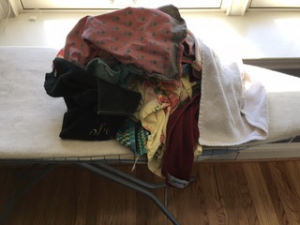
Take this example of table linens – out of the dryer and onto a folding surface.
Task Batched Folding Steps would look like this:
• Sort clean laundry into categories: if you mix loads from a whole household, your first sort job will be by person, then by category of clothing (socks, underwear, shirts that fold, shirts that hang, bottoms, work out clothing, pajamas…etc).
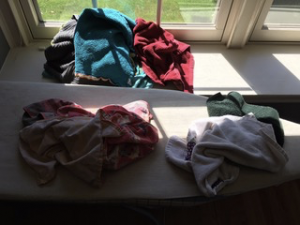
Step 1: sort into categories: this load broke down into hand towels, dish towels and cloth napkins.
• Prep each category so it’s ready to be folded (right any clothes that are inside out or button collars).
• Fold each category separately – meaning one category at a time – preferably on a clean and flat surface.
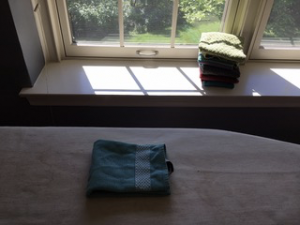
• Do all of your folding at once.
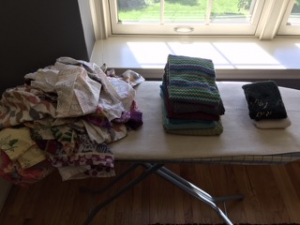
Step 2: fold each mini pile as its own category.
Our cloth napkins need to be ironed so they’ll stay on the ironing board.
The other 2 folded piles will go into their appropriate drawers in the kitchen.
Will task batching your folding process solve all of your laundry dilemma’s? No — but folding by category allows you to delegate small pieces of the project to even the youngest helpers and lets others take pride in the smooth running of the household if you’re lucky enough to live with people who will “volunteer” or as in our household, be volunteered to help 🙂
 Here are some strategies that can help. The example we’ll use applies them to paper clutter, but they can help you get moving on any clutter-busting project.
Here are some strategies that can help. The example we’ll use applies them to paper clutter, but they can help you get moving on any clutter-busting project.
Often, seeing something concrete will get you moving, especially if you’re a visual person.
“Where did all this stuff come from anyway? How did it all fit in here in the first place? I can’t believe how long this is taking and how many boxes we have! AAAaahhhh!!!!”
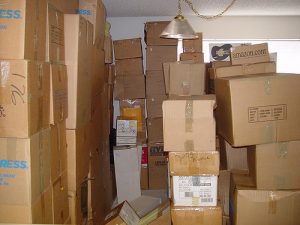
Well, it’s true. When we pull everything out of its storage space, we can see the volume of what we really have. And, for those things that haven’t been seen or touched in years: much of it is astonishing.
“Cans of hairspray? Wait. I haven’t bought hairspray in a can in at least 2…uh, 5…oh, I don’t know – better throw that out. How did these shoes get back here? Man, they’re dusty. And sort of misshapen. Well, okay very misshapen. Nevermind. Out! And, wait. Do we really have 6 new containers of black pepper? Six? I had no idea. This will last us forever!”
You are moving into a new home. Whether larger or smaller than your last, it’s an opportunity to get organized – right from the start! Here are 6 spaces to set up when you move in so you can get and stay organized:
Spice Storage: There are so many options for organizing spices that there is really no reason you need to fight to find what you need, have bottles and jars falling out onto you as you reach behind, or repurchase multiples of what you already have. 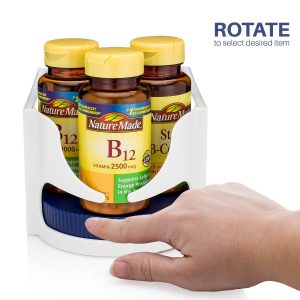
Pantry: DIY or go the extra mile and get pro-installation. A pantry organizing system will be a delight to your family today and a great selling point tomorrow.
Under Sinks: Either in the kitchen or bathrooms, under sink storage will make ALL the difference. Enjoy the control and say goodbye to yucky under-sink messes!
Shoes: The struggle is real. First decide where you want to store them (By the entryway? In a closet? Under the bed? In the garage?) Then, reign them in.
Bedroom Closets: If you are renting a home, you may want to save money and purchase some temporary solutions that you can take with you when you move out. For homeowners, installing built-ins is the way to go.
Storage Area: Before you go building columns and walls of heavy boxes stacked one atop another; stop and think. This is what got you into the last mess of storage chaos. Is there room for some shelving? Is there ceiling or wall space to be taken advantage of?
As a professional organizer, I have seen more than my fair share of wedding gifts…
But not exactly as you’d expect…
I see them years after the big day…
…in their original boxes,
…collecting dust,
…tucked away in a closet or in storage.
Think ice cream maker (sure, sounds super fun but…), bread maker, fine china, crystal…
In recent years, there has been a real shift in registry selections, a move from traditional household items towards experiences, accessories to fuel their hobbies and lifestyle while still embracing good old gift cards, but to new locales, services.
As a professional organizer, I LOVE that modern, engaged couples are choosing to pack their registries with low clutter or clutter-free options!
So how can you, as a newlywed, plan a better registry with functional (and fun) items you’ll use and love vs those that you won’t? Check out our practical tips to your best wedding registry.
3 Practical Questions To Ask When Planning Your Registry
Does This Make Sense With Our Lifestyle?
Think about your lifestyle right now, as a couple. Do you love to make elaborate meals together, entertain family & friends? Or are you a couple who orders Hello Fresh or prefers to eat out due to busy schedules? How necessary is an 8-piece professional knife set or a Cuisinart Dual Blade 8qt Mixer or the 10-piece mixing bowl set if you have a compact kitchen? Are you planning to start a family right away or is travel and entertainment on your immediate agenda?
Think about what fits your lifestyle as a couple. For example, my husband was a chef, in a previous life, so the kitchen tools we received as wedding gifts have been well-loved & well-used over the years! So DO register for what you love…whether it’s cooking or entertaining, camping or traveling!
If you’re already keeping your life simple, don’t clutter up your kitchen or other spaces with big bulky items you’ll use once or never at all.
What Do We Already Have?
If you and your soon-to-be spouse lived in separate homes before getting married, now is the perfect time to see what you already have for your new space. Put everything where you want it. You may find that your future spouse already has a brand new Kitchen Aid Mixer and a set of glass mixing bowls, so no need to register for them. Have extra towels? Set some aside for guests.
Now you’ll have a great idea of…
…what you’re missing or might need,
…what is on its last legs and needs to be replaced,
…what items are duplicates and can be donated or passed along to a friend.
Repeat this process in every room in your home – declutter, evaluate, and adjust your registry accordingly.
But make no mistake…merging households could require quite a bit of decluttering…definitely more so than starting from scratch.
What Would Our Future Selves Do?
Your wedding registry is all about your future, so fast forward…5, 10, 15 years…
Do you see yourself using that must have juicer?
Are those higher thread count sheets really a priority?
Do you really need a 6-slice toaster or should you opt for nicer everyday towels?
Will being married motivate you to make your own bread?
Will you ever really host formal dinners that require fine china & crystal?
As someone who has been married for 15 years, I can tell you that, over the years, we’ve donated at least half of our wedding gifts…for one reason or another. Remember less is more so don’t overdo it…but get what you love to make your house a home! Good luck!
Spring is finally springing up all around us, daffodils are blooming and the forsythia is blossoming into that amazing yellow color.
Easter and Passover are a time of new beginnings. April is also the month we celebrate the earth. Earth Day began in Philadelphia in 1970 (Belmont Plateau anyone?). In the organizing and productivity industry, we consider every day Earth Day! When we work with clients on a home organizing project, we teach our clients about recycling. There is so much that we recycle to help preserve our earth. Here are some of the resources that we use to locate the most appropriate place to donate and recycle in our area:
However currently there is an abundance of stuff that people are getting rid of, they are very picky, so what you try to consign has to be in very good condition.
Depending on what you have there is usually an auction house or specialty sale that items can go to. When you sell at auction houses and consignment shops there is a fee usually between 30% and 50%.